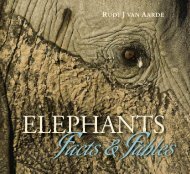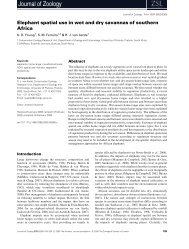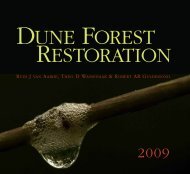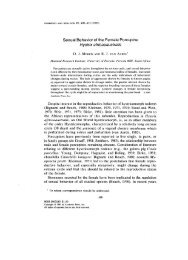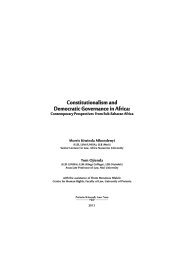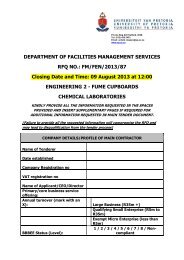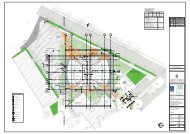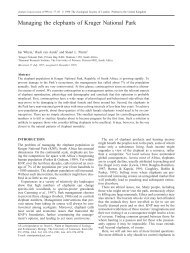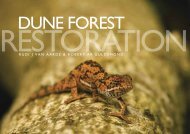Demography of a Cape porcupine, Hystrix africaeaustralis ... - CERU
Demography of a Cape porcupine, Hystrix africaeaustralis ... - CERU
Demography of a Cape porcupine, Hystrix africaeaustralis ... - CERU
Create successful ePaper yourself
Turn your PDF publications into a flip-book with our unique Google optimized e-Paper software.
J. Zool., Lond. (1987) 213, 205~212<br />
<strong>Demography</strong> <strong>of</strong> a <strong>Cape</strong> <strong>porcupine</strong>, <strong>Hystrix</strong><br />
<strong>africaeaustralis</strong>, population<br />
R. 1. VAN AARDE<br />
Mammal Research Institute, University oj" Pretoria, Pretoria 0002, South Africa<br />
(Accepted 17 February 1987)<br />
(With 2 figures in the text)<br />
The <strong>Cape</strong> <strong>porcupine</strong> is a large (12·0 kg), nocturnal hystriwmorph rodent and widely distributed<br />
throughout southern Africa. The prcsent paper examines age-specific survival, mortality and<br />
fecundity rates in a population, evaluates the roles <strong>of</strong> possible density-dependent changes <strong>of</strong><br />
population parameters in the regulation <strong>of</strong> <strong>porcupine</strong> numbers, and describes the life history<br />
strategy <strong>of</strong> the species. The study is based on data sets obtained from animals collected during<br />
1977/78 and during 1981/82. Changes in demographic characteristics are ascribed to an artificial<br />
reduction in density, resulting in the relaxation <strong>of</strong>social factors inhibiting reproduction in young<br />
adults.<br />
Contents<br />
Page<br />
Introduction .. 205<br />
Study area .. 206<br />
Materials and methods 206<br />
Results .. 206<br />
Fecundity .. 206<br />
Age structure 207<br />
Survival and mortality rates 207<br />
Social organization .. 208<br />
Discussion 210<br />
Summary 211<br />
References 212<br />
Introduction<br />
<strong>Cape</strong> <strong>porcupine</strong>s, <strong>Hystrix</strong> <strong>africaeaustralis</strong>, appear to have a wide ecological tolerance since they<br />
occur in most habitats throughout southern Africa. Porcupines are large (12 kg; van Aarde, 1987)<br />
hystricomorph rodents, attain sexual maturity during their second year <strong>of</strong>life (van Aarde, 1985a;<br />
van Aarde & Skinner, 1986), are monogamous (Morris & van Aarde, 1985), breed seasonally in<br />
summer rainfall areas (van Aarde, 1985a), live in extended family groups, and can live for up to 20<br />
years in captivity (Kingdon, 1974). Litter size varies from 1~3, and adult pairs produce only a<br />
single litter per year (van Aarde, 1985a). No information has as yet been published on their<br />
population biology.<br />
The artificial reduction <strong>of</strong> the numbers <strong>of</strong> <strong>porcupine</strong>s on the Tussen-die-Riviere Game Farm<br />
(30 0 25'S, 26°12'E), as part <strong>of</strong> a management programme, provided the material required for<br />
defining demographic characteristics <strong>of</strong> the population. The present paper reports on age-specific<br />
205<br />
0022-5460/87/010205+08 SOHIO co 1987 The Zoological Society <strong>of</strong> London
206 R. J. VAN AARDE<br />
survival, mortality and fecundity rates, and seasonal changes <strong>of</strong> the age structure <strong>of</strong> the<br />
population. Furthermore, it attempts to evaluate the role <strong>of</strong>possible density-dependent changes <strong>of</strong><br />
population parameters in the regulation <strong>of</strong> population size, and describes the life history strategy<br />
<strong>of</strong> the species.<br />
Study area<br />
The Tussen-die- Riviere Game Farm, is situated at the confluence <strong>of</strong> the Orange and Caledon<br />
rivers in the False Upper Karoo Veld Type <strong>of</strong> South Africa. The area is subjected to seasonal<br />
climatic conditions and is defined as arid, with the summer rainy season extending from November<br />
to April. The average annual rainfall has been recorded at 440 mm (Werger, 1980). The average<br />
daily minimum temperature is 0·1 °C for the coldest month (J uly) and the average maximum daily<br />
temperature for the hottest month (January) is 31·2 °C (Werger, 1973).<br />
The <strong>porcupine</strong> population living there probably originated from <strong>porcupine</strong>s present within the<br />
area when it was fenced (22,000 ha) as a Game Farm. No large carnivores lived on the Game Farm<br />
since its inception during 1967 and thus, for about 20 years before the study, <strong>porcupine</strong>s were not<br />
exposed to predation or culling operations.<br />
Material and methods<br />
As part <strong>of</strong> a management programme, all porcupincs cncountered at night in the beam <strong>of</strong>a spotlight were<br />
killed at bimonthly intervals between February 1977 and January 1978 (n = 82) and from July 1981 to July<br />
1982 (n = 118). Dead <strong>porcupine</strong>s were weighed, sexed, and female reproductive tracts were inspected<br />
macroscopically for implantations and placental scars. Foetal ages were determined as described by van<br />
Aarde (1987), and conception and birth dates for each litter were calculated as the sampling da!e minus foctal<br />
age and the conception date plus 93 days (gestation period), respectively.<br />
Examination <strong>of</strong> maxillar toothrows provided an opportunity to assign each specimen to I <strong>of</strong>9 dental age<br />
classes. Chronological age was assigned to 6 <strong>of</strong> these on the basis <strong>of</strong> the age-specific sequence <strong>of</strong> tooth<br />
eruption and replacement recorded in known-age specimens (11 = 23; see van Aarde, 1985b).<br />
Analyses <strong>of</strong> the age structures <strong>of</strong> the 2 subsamples were based on the assumption that the standing age<br />
distribution (the number <strong>of</strong>animals relative to the number <strong>of</strong>new-born in each age class at the time <strong>of</strong>culling)<br />
represented a stable age distribution. Age-specific probability <strong>of</strong> surviving (I,), probability <strong>of</strong> dying (d x),<br />
mortality rates (qx) and fecundity rates (m.) were calculated following Caughley (1977). The calculation <strong>of</strong>net<br />
reproductive rates (R,,) (Elseth & Baumgardner, 1981) was based on the assumption that the probability <strong>of</strong><br />
survival <strong>of</strong> adults (h-Ilo) decreases constantly with age (x) (see Silver, 1979), that longevity in the wild is 10<br />
years and that fecundity rate (mx) for <strong>porcupine</strong>s older than 24 months <strong>of</strong>age (mrmlO) remained constant. It<br />
is believed that the interval between sampling (3 years) was enough to allow the age distribution to converge<br />
to stability.<br />
Information on social organization was obtained from captive animals (see Morris & van Aarde, 1985; van<br />
Aarde, 1985c), from <strong>porcupine</strong>s trapped at their burrows at various loealities in the Karoo, and from<br />
<strong>porcupine</strong>s observed foraging at night on the Tussen-die-Riviere Game Farm.<br />
All means are followed by one standard deviation (± S.D.) <strong>of</strong> the mean, unless otherwise indicated.<br />
Results<br />
Fecundity<br />
Extrapolation <strong>of</strong> birth dates based on the estimated ages <strong>of</strong> foetuses on the date <strong>of</strong> collection<br />
suggests that all births occurred from August to March, with a pcak in January. The mean date <strong>of</strong>
DEMOGRAPHY OF HYSTRIX AFRICAEAUSTRALIS<br />
TABLE I<br />
Age-specificfecundity schedules for the <strong>porcupine</strong> population 011 the Tussen-die<br />
Riviere Game Farm, based on the assumption tllat litter size at birth equals liller<br />
size in captivity. (Sample sizes included in parenthesis)<br />
207<br />
Percentage reproductively<br />
Female births per<br />
active during breeding<br />
female per season<br />
season<br />
(mx)<br />
Age<br />
(months) 1977/78 1981/lQ 1977/78 1981/82<br />
< 6 0·0 (5) 0·0 (18) 0·00 0·00<br />
> 6~ 12 0·0 (5) 75·0 (4) 0·00 0·56<br />
> 12~24 63-6 (II) 88·9 (9) 0·48 0'67<br />
>24 88·2 (17) 95·7 (22) 0·66 0·72<br />
birth for 19 litters was 21 December ± 18·6 (S.E.) days. Litter size at birth for free-ranging females<br />
is unknown, but their prenatal litter size was similar to that in captive females (x = I· 5 ± 0'66;<br />
n= 165). Moreover, placental scars recorded in 28 free-ranging lactating females averaged<br />
1·4±0·5. Sex ratio at birth did not deviate from unity (X 2 =0'55; 11=23) and the average annual<br />
incidence <strong>of</strong> pregnancy (Caughley, 1977) was \·2, suggesting that free-ranging females produced<br />
one litter per year.<br />
Age-specific fecundity schedules (mx) based on the information given above and the frequency<br />
<strong>of</strong> occurrence <strong>of</strong> reproductively active females is provided in Table I. None <strong>of</strong> the females> 6<br />
months and:::; 12 months collected during 1977/78 were reproductively active, while three <strong>of</strong> four<br />
females in this age class reproduced during 1981/82 (Table I). Age-specific fecundity for other age<br />
classes were also higher during 1981/82 than during 1977/78 (see Table I). The average annual<br />
production <strong>of</strong> female <strong>of</strong>fspring per female older than six months was 0-49 in 1977/78 and 0·69 in<br />
1981/82.<br />
Age structure<br />
Age composition <strong>of</strong>both the 1977/78 and 1981/82 populations changed seasonally, and differed<br />
considerably from eaeh other (Fig. I). The biphasic pattern in the presence <strong>of</strong> <strong>porcupine</strong>s ::;; 12<br />
months <strong>of</strong> age during 1977/78 was not evident during 1981/82 (Fig. 1). The monthly contribution<br />
<strong>of</strong> the first year age class to the total subsample varied from 14·3-15·5% (x = 32 ± 16·9'1'0; 11 = 6)<br />
during 1977/78 and from 42,0-55,5% (x =46·2± 8'5'%; f1 = 6) in 1981/82. Standing age distribution<br />
<strong>of</strong> male and female cohorts was similar during botb sampling periods (X 2 =0'74 and ]·51,<br />
respectively; df. = 3). Pooled data for the sexes indicate a significant difference (Xl = 21·5;<br />
P < 0·001; df. = 7) in the age structures <strong>of</strong> the two subsamples. This difference was also significant<br />
(X2 = 10·8; P < 0·05; df. = 3) when reducing the nine dental age classes to four chronological age<br />
classes ( < 6 months, 6-12 months, > 12-24 months, and> 24 months).<br />
Survival and mortality rates<br />
Data on age-specific probability <strong>of</strong>survival (1 x), probability <strong>of</strong>dying (dx) and mortality rate (qx)<br />
are provided in Table II. Life table statistics suggest a low mortality rate during the first two<br />
months <strong>of</strong> life, which increased to 0·445 and 0·669 during the first year <strong>of</strong> life (Table II). The
208 R. J. VAN AARDE<br />
100-~----------------------~<br />
1977/78<br />
n=82<br />
~ 20<br />
~<br />
1981/82<br />
n=118<br />
(J) <br />
QJ <br />
c<br />
.0..<br />
::J<br />
u<br />
0<br />
0.<br />
'0 100<br />
....<br />
QJ<br />
.0<br />
E<br />
::J 80<br />
z<br />
60<br />
40<br />
80<br />
20<br />
J M M J s D<br />
Months<br />
FlU. I. Seasonal changes in the age strudures <strong>of</strong> the <strong>porcupine</strong> population on the Tusscn-die-Riviere Game Farm as<br />
reflected by subsamples collected between February 1977 and January 1978 (/I = 82) and between September 1981 and July<br />
1982 (/1 = I [8). 0 = < 6 months; III:l = > 6 ~ 12 months; D > [2 ~ 24 months; 0 = > 24 months.<br />
probability <strong>of</strong> surviving to an age <strong>of</strong> 18 months was 0-464 and 0·331 during 1977/78 and 1981/82,<br />
respecti vel y.<br />
Apparent differences in net reproductive rates between the two subsamples, using the equation<br />
Ro=I:lxmx (see Elseth & Baumgardner, 1981), mainly result from an earlier age at first<br />
reproduction during 1981/82 rather than during 1977/78 (Fig. 2).<br />
Social organi::a tion<br />
Most (89·3'Yr,) <strong>porcupine</strong>s encountered foraging (11= 118) at night were solitary. Groups<br />
comprising two individuals were seen on seven occasions, while three individuals foraging together<br />
were seen twice only. Three <strong>of</strong> the seven pairs comprised one adult male and one adult female (all<br />
females pregnant), while other pairs (11=4) comprised an adult male and a juvenile, 2-5-5-5
, ,<br />
~<br />
DEMOGRAPHY OF l/YSTRIX AFRICAEAUSTRALIS<br />
T AHLE II <br />
Age-specific probability <strong>of</strong>surviving (Ix) ami dying ((/,) fi)l- the 1977/78 alld /981/82 porcupille populations based <br />
0/1 the assumption thai the standing age distribution equals temporal age distrihution. (.See Caughley for <br />
deftnil ions) <br />
Probability Probability Mortality<br />
Median Frequency* <strong>of</strong> surviving <strong>of</strong> dying rate<br />
Age age (fx) (Ix) (d,) (qx)<br />
(months) (months)<br />
-----<br />
(x) (x+x+ 1/2) 1977/78 81/82 1977/78 81/82 1977/78 81/82 1977/78 81/82<br />
. __._-------<br />
~~--------<br />
0-2 I 32'3"* 51'4** ),000 )'000**** 0'164 0·000 0·164 0-000<br />
> 2~ 12 7 27·0 53-0*** 0·836 1-000 0·372 0·669 0-445 0·669<br />
> 12$24 18 15·0 17·0 0·464 0-331<br />
>24 38-0 48·0<br />
* Age-specific sex ratios did not differ significantly and data for males and females were therefore<br />
combined<br />
** Estimated from agc-specific fecundity schcdules and presents the expected number <strong>of</strong>new-born females<br />
within the subsamples<br />
*** 13-64% <strong>of</strong> females in this class were reproductively active and mx thus O' 102 <br />
**** fx at x + I larger than at x and Ix thus 1·000 <br />
209<br />
1·0<br />
0·5<br />
2 4 6 8 10<br />
Age (years)<br />
FIG. 2. Age-specific changes in Ixmx values for the <strong>porcupine</strong> population on the Tussen-die-Riviere Game Farm,<br />
illustrating that diffcrences in net reproductive rates between the two subsamples resulted from an earlier age at first<br />
reproduction during 1981/82 (.-.) than during 1977/78 (. -.).<br />
months <strong>of</strong> age. Both groups <strong>of</strong> three comprised an ad ult male, an adult female and a juvenile. All<br />
adult males encountered in groups were more than 24 months <strong>of</strong> age.<br />
Groups trapped at the same burrows comprised an adult male and an adult female (n = 4), an<br />
adult male and a juvenile (ll = 3), juveniles only (n = 2), an adult male, adult female and a juvenile<br />
(n = 2) and an adult male, adult female, two subadults and two juveniles (n = 2). It is not known if<br />
all animals in each group were caught.
210 R. J. VAN AARDE<br />
The number <strong>of</strong> reproducing females in captive groups corresponded to the number <strong>of</strong> adult<br />
males present within the group. Only one <strong>of</strong> two females housed with a male (n=4 groups)<br />
reproduced over a two-year-period. This was also the case when three females were housed with<br />
one adult male (n = 2 groups). In two cases where two adult females were housed with two adult<br />
males, both females reproduced.<br />
None <strong>of</strong>the three females kept in natal groups up to the age <strong>of</strong>three years reproduced, in spite <strong>of</strong><br />
regular cyclic ovarian activity and the presence <strong>of</strong> unrelated males. They, however, reproduced<br />
within six months after being separated from their natal groups. Incest was ncver recorded.<br />
Discussion<br />
Harvesting has become an important measure in the management <strong>of</strong> confined mammal<br />
populations. In spite <strong>of</strong> several shortcomings in data obtained during such operations (i.e. nonrandom<br />
sampling, and insufficient sample sizes), scientists studying population dynamics have<br />
little other material on which to rely. Moreover, relatively little is known about the dynamics and<br />
regulation <strong>of</strong> African mammal populations.<br />
Mechanisms <strong>of</strong> population regulation have been widely discussed for decades (see Krebs, 1978<br />
for references), and it is accepted, as a general axiom, that popUlations reach equilibrium under<br />
particular environmental conditions, with rates <strong>of</strong> reproduction and mortality being affected by<br />
density (Krebs, 1985). Krebs (1978) suggested that the factors involved in maintaining stability in<br />
populations can best be evaluated through the manipulation <strong>of</strong> numbers. By artificially reducing<br />
numbers (density), and by quantifying the effect(s) <strong>of</strong> this manipulation on demographic<br />
characteristics, as attempted in the present analysis, insight may be gained into the mechanisms<br />
underlying the regulation <strong>of</strong> numbers and thus the long-term stability in density.<br />
In spite <strong>of</strong>the inability to assign annual age classes to <strong>porcupine</strong>s older than 24 months (see van<br />
Aarde, 1985b), which precluded the derivation <strong>of</strong> full life tables, and limited sample sizes, the<br />
present investigation suggests important differences in certain demographic characteristics<br />
between the 1977/78 and 1981/82 subsample. Changes in age-specific fecundity and first year<br />
survival may be attributed to environmental changes but rainfall figures for the sampling periods,<br />
and presumably therefore primary productivity, do not support such a hypothesis. Forces<br />
responsible for the observed differences may be explained in terms <strong>of</strong> changes in popUlation<br />
densities, induced by the first culling operation, as follows:<br />
Porcupines live in extended family groups where each group comprises at least an adult male,<br />
one adult reproducing female and a varying number <strong>of</strong> siblings. Both parents take care <strong>of</strong> the<br />
young, and males, actively protecting young against intruders (van Aardc, unpubl. obs.),<br />
accompany them during foraging excursions for the first few months <strong>of</strong>life. This may contribute to<br />
high juvenile survival rates during the early stages <strong>of</strong> life (see Table II).<br />
Age-specific fecundity rates (Table J) during 1981/82 (after reduction in density) were higher<br />
than during 1977/78. Reproductive activity also commenced at an earlier age during 1981/82 than<br />
during 1977/78. Considering that reproduction is limited by monogamy, is seasonal and that<br />
dispersal <strong>of</strong> young may be reduced as a result <strong>of</strong> high density, population reduction could have<br />
resulted in an earlier age at first reproduction and thus the increase in age-specific fecundity.<br />
Unfortunately, sample size for females 6-12 months <strong>of</strong> age are insufficient to show statistically<br />
significant change in age-specific fecundi ty rates. The observed trend is nevertheless <strong>of</strong>interest and<br />
the conclusion that age-specific fecundity is a factor <strong>of</strong> density should be considered cautiously.
DEMOGRAPHY OF HYSTRIX AFRICA EA USTRALIS<br />
211<br />
It thus appears that the most important response <strong>of</strong> the studied population to the reduction in<br />
density was a change in age-specific productivity, which would conceivably affect population<br />
growth rate. The present analysis thus suggests that <strong>porcupine</strong> numbers are, at least partly,<br />
regulated through social factors affecting reproductive activity. It appears that age at first<br />
reproduction is the most important demographic mechanism responsible for population changes,<br />
implying that the regulation <strong>of</strong> their numbers under the conditions <strong>of</strong>the present examination, i.e.<br />
in the absence <strong>of</strong> predators, is density-dependent.<br />
The relationship between habitat, ecological strategies and population parameters can be<br />
explained in terms <strong>of</strong>r- and K-selection and this approach features prominently in the analysis <strong>of</strong><br />
life-history tactics (Stearns, 1976). K-selection is gcared towards the efficient use <strong>of</strong>environmental<br />
resources and favours interoparity, an extended life-span, delayed sexual maturity, small litters,<br />
large body size and intensive parental care (Pianka, 1970).<br />
The <strong>porcupine</strong>, a relatively large rodent with a long gestation period (93 days), small litter size<br />
~md a long life-span (van Aarde, 1985a, b), may be considered a K-strategist. This is supported by<br />
the analysis <strong>of</strong> the demographic characteristics <strong>of</strong> the free-ranging population studied during the<br />
present investigation, which suggests that density is regulated by the dependence <strong>of</strong> reproductive<br />
activity on social factors. Other reproductive attributes, such as the extended lactation period, low<br />
<strong>of</strong>fspring: adult weight ratio and intensive parental care, support a reproductive strategy that<br />
involves a large parental investment in a small number <strong>of</strong><strong>of</strong>fspring. This predicts a high chance <strong>of</strong><br />
survival for each <strong>of</strong>fspring as shown during this investigation.<br />
Summary<br />
<strong>Cape</strong> <strong>porcupine</strong>s <strong>Hystrix</strong> <strong>africaeaustralis</strong> apparently have a wide ecological tolerance and occur<br />
commonly in most habitat types throughout the southern African subregion. The present paper<br />
describes demographic characteristics <strong>of</strong> a population inhabiting the Tussen-die-Riviere Game<br />
Farm situated in the False Upper Karoo (South Africa). This analysis is based on two independent<br />
subsamples collected at bimonthly intervals during 1977/78 and 1981/82, the first representing a<br />
population not exposed to natural or artificial predation for 20 years, and the second a population<br />
3·5 years after a reduction in density.<br />
A comparison <strong>of</strong> statistics derived from the two subsamples revealed a change in age structure<br />
and age-specific fecundity rates. The increase in the age-specific fecundity rates is ascribed to a<br />
reduction in age at sexual maturity which would affect net reproductive rate and population<br />
growth ra teo<br />
A decrease in density conceivably permitted <strong>of</strong>fspring to disperse from their family groups and,<br />
considering that reproduction within a group is limited to parents, dispersal due to 'vacancies'<br />
created by the first culling operation may explain the earlier age at first reproduction thereafter. It<br />
thus appears that age at first reproduction is the most important mechanism responsible for<br />
changes in population growth rates, suggesting that regulation <strong>of</strong> numbers results from the<br />
effect(s) <strong>of</strong> social factors on reproductive output.<br />
Financial support was provided by the University <strong>of</strong>Pretoria, and the Council for Scientific and Industrial<br />
Research. Assistance and hospitality received from the Nature Conservation and Management Branch <strong>of</strong>the<br />
Provincial Administration <strong>of</strong>the Orange Free State is gratefully acknowledged. Messrs M. Haupt, D. Majola<br />
and W. Nel provided technical assistance. This rormed part <strong>of</strong>a wider study for a doctoral thesis for which I<br />
was the recipient <strong>of</strong> the Maberly Memorial Scholarship <strong>of</strong> the Transvaal Branch <strong>of</strong> the Wildlife Society <strong>of</strong><br />
Southern Africa.
212 R. J. VAN AARDE<br />
REFERENCES<br />
Caughley, G. (1977). Alla(l'sis o(vertehrafe populatiolls. New York: John Wiley & Sons. <br />
Elseth, C. D, & Baumgardner, K. D. (lnl). Population hiology. New York: D, von Nostrant Co. <br />
Kingdon, J. (1974). East African mammals: An at/as o/evolUlion in A/rica 2, Part B, London & New York: Academic Press. <br />
Krebs, C. J. (1978). A review <strong>of</strong> the Chitty Hypothesis <strong>of</strong> population regulation. Call. J, Zool. 12: 2463-2480. <br />
Krebs, C. J. (1985). Ecology. The experimental analysis o/'distrihution alld ahundance. 3rd edn. New York: Harper & Row. <br />
Morris, D. & van Aarde, R. J. (1985). Sexual behavior <strong>of</strong> the female <strong>porcupine</strong> <strong>Hystrix</strong> a/ricaeaustralis. Harm. Behav. 19: <br />
400-412.<br />
Pianka, E. R. (1970). On "r" and "K" selection Am. Nat. 104: 592-597.<br />
Silver, W. (1979). A competing-risk model for animal mortality. Ecology 60: 750-757.<br />
Stearns, S. C. (1976). Life history tactics: a review <strong>of</strong> the ideas. Q. Rel'. Bioi. 51: 3-47.<br />
van Aarde, R. J. (1985a). Reproduction in captive female <strong>Cape</strong> <strong>porcupine</strong>s (<strong>Hystrix</strong> cdi-icaeallstralis). J. Reprod. Fert. 75:<br />
577-582.<br />
van Aarde, R. J. (l985b). Age determination in the <strong>Cape</strong> <strong>porcupine</strong> (<strong>Hystrix</strong> a/ricaeallstralis). S. A/I'. J. Zoo!. 20: 232-236.<br />
van Aarde, R. J. (1985c). Husbandry and immobili;mtion <strong>of</strong>captive <strong>porcupine</strong>s (<strong>Hystrix</strong><strong>africaeaustralis</strong>). S. Afr. J. Wild/.<br />
Res. 15: 77-79.<br />
van Aarde, R. J. (1987). Pre- and postnatal growth <strong>of</strong>the <strong>Cape</strong> <strong>porcupine</strong> <strong>Hystrix</strong> q/iicaeaustralis. J. Zoo/., L(JIld. 21 t: 25=<br />
33.<br />
van Aarde, R. J. & Skinner, J. D. (1986). Reproductive biology <strong>of</strong> the male <strong>Cape</strong> <strong>porcupine</strong>, <strong>Hystrix</strong> a/ricaeaustralis.<br />
J. Reprod. Fert. 76: 545-552.<br />
Werger, M. J. A. (1973). An account <strong>of</strong>the plant communities <strong>of</strong>Tussen-die-Riviere Game Farm, O.F.S. Bothalia 11: 165<br />
176.<br />
Werger, M. J. A. (1980). Phytosociological study <strong>of</strong> the Upper Orange River valley. Mem. Bot. Sun). S. Afr.46: 1-98.




